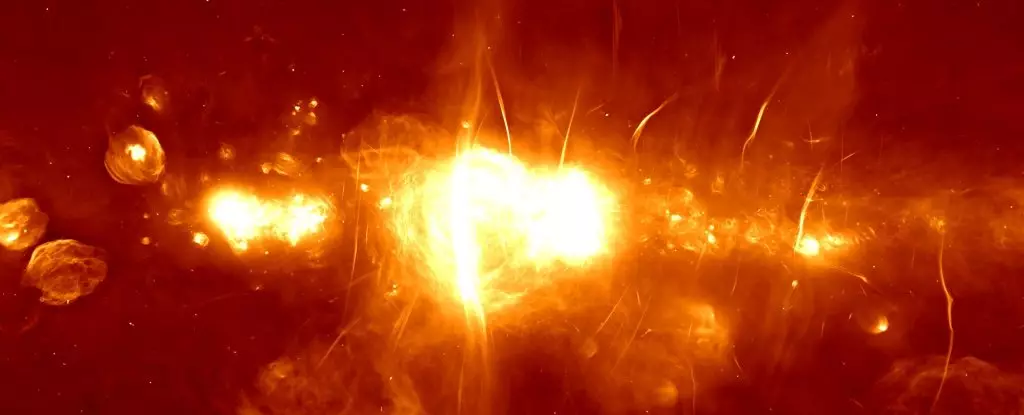In the chaotic heart of our Milky Way galaxy, a groundbreaking discovery has shifted the paradigm of our understanding of cosmic structures. Astronomers, led by Kai Yang from Shanghai Jiao Tong University, have unearthed a novel phenomenon in the Central Molecular Zone (CMZ)—a region notoriously challenging to study due to its dense composition of gas and dust. What they stumbled upon defies previous categorizations of cosmic filaments and has been aptly named “slim filaments.” This term embodies the unexpected nature of these structures, which act as agents of material circulation, reminiscent of tornadoes here on Earth.
The CMZ serves as a treasure trove of molecular gas, housing about 80 percent of the galaxy’s dense gases. This environment is not only rich in matter, but it is an arena of relentless activity, where clouds are constantly colliding, breaking apart, and reforming with alarming velocity—up to 100 kilometers per second. The turbulence present in this area hints at processes that have remained enigmatic until now; poorly understood mechanisms have obscured the dynamics of gas dispersal throughout the CMZ.
ALMA’s Role in Unveiling Cosmic Mysteries
To probe these mysteries, the research team utilized the Atacama Large Millimeter/submillimeter Array (ALMA) in Chile, a powerful tool for observational astronomy. Their focus was primarily on silicon monoxide, a gas critical for diagnosing shock interactions in the CMZ. What they uncovered, however, was not merely a confirmation of known structures, but rather an astonishing array of long, slender filaments differing greatly from previously observed galactic filaments.
This discovery unexpectedly broadened our comprehension of how matter moves and interacts in a galactic environment. Yang’s research team meticulously scrutinized the properties of these slim filaments and unveiled an intricate composition featuring organic molecules—cyclopropenylidene, formaldehyde, and methanol, to name a few. In a cosmos where chaos reigns, these filaments emerge as ordered structures amidst the tumult, contributing significantly to our understanding of interstellar chemistry and physics.
Understanding ‘Slim Filaments’ and Their Turbulent Nature
The slim filaments are noteworthy for their unique velocity distributions, which diverge from typical measurements of other filaments found in the CMZ. This peculiarity signifies a dominance of turbulent pressures, making these structures akin to terrestrial tornadoes or dust devils. They appear to discharge gases efficiently into the surrounding environment, acting like cosmic plumbing that circulates materials through the complexities of space.
Yet the genesis of these slim filaments remains shrouded in mystery. The researchers postulate that shocks, the result of violent collisions within the CMZ, instigate the turbulence from which these structures evolve. Such turbulence can heat complex molecules into a gaseous state before they are redistributed upon cooling, rejuvenating the CMZ’s molecular inventory. The implications are profound; it indicates a system of recycling that could explain a significant portion of material transformation and circulation in this galactic region.
The Broader Implications of Galactic Findings
The revelation of slim filaments serves as a pivotal piece in the larger puzzle of the Milky Way’s lifecycle. Understanding the mechanisms behind these structures could provide insights into how galaxies evolve, grow, and influence their environments. Furthermore, it reveals the dynamic nature of the CMZ, challenging previous assumptions regarding the relative stability of galactic centers. The notion that there may exist different classes of filaments—specifically those like slim filaments, shaped by shock interactions—broadens the scientific dialogue surrounding cosmic structures.
Moreover, this finding signals a larger trend in astronomical research: a growing appreciation of the complex interplay of forces acting on gaseous clouds. As scientists dive deeper into the realms of molecular structures, it is becoming increasingly apparent that our universe is anything but static. The discovery of slim filaments is a testament to the relentless pursuit of knowledge and exploration, demonstrating humanity’s determination to decode the mysteries of our cosmos.
In this time of astronomical awakening, the implications of these findings can influence future studies aimed at unveiling the intricacies of galactic behavior. Researchers may increasingly seek to understand not only the physical properties of such structures but also their chemical implications on star formation, planetary development, and the evolutionary pathways of galaxies.
This remarkable journey into the heart of the Milky Way highlights the beauty of scientific discovery—a reminder that the cosmos still holds secrets waiting to be revealed in the vastness of space. The slim filaments may be just the beginning of a deeper exploration into the turbulent, dynamic dance of gas that fuels the heart of our galaxy. As we look to the stars, who knows what incredible structures and phenomena await next?


Leave a Reply